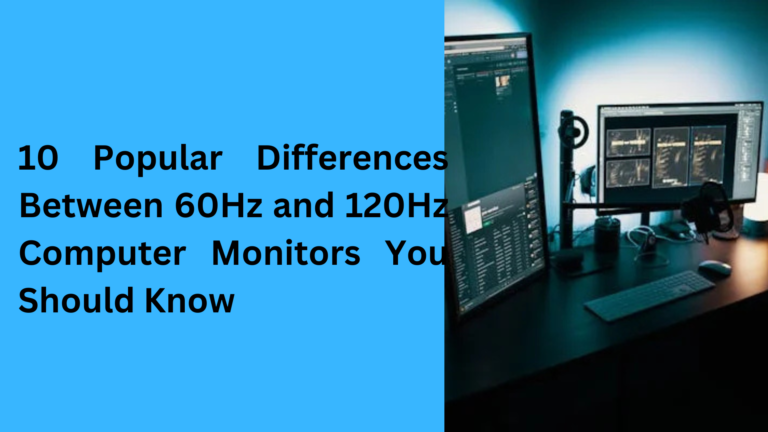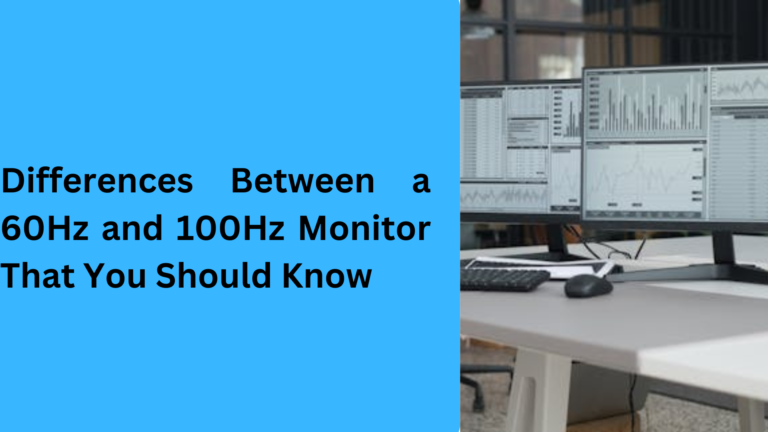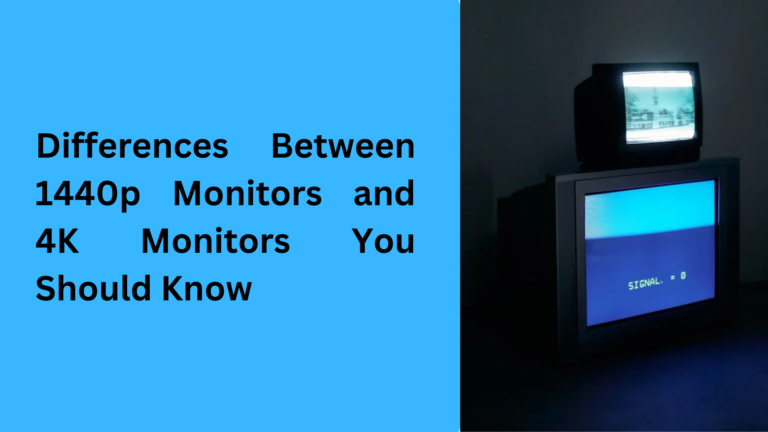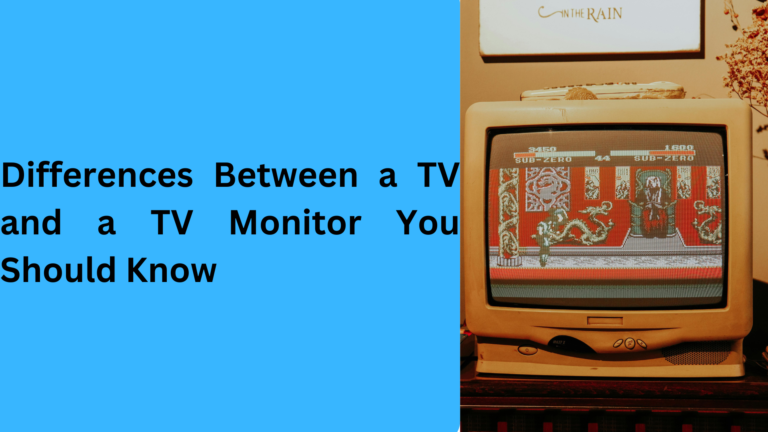10 Key Differences Between a 120Hz and 60Hz Monitor You Should Know
When you’re shopping for a new monitor, one of the key features you’ll come across is the refresh rate. A monitor’s refresh rate indicates how many times per second it can refresh the image on your screen. Common options are 60Hz and 120Hz. But what do these numbers mean, and why should you care? In this article, we’ll explore the differences between a 120Hz and 60Hz monitor and help you make an informed decision based on your needs.
1. Smoothness and Fluidity: The Key Difference Between 120Hz and 60Hz Monitors
A major difference that becomes noticeable when comparing a 120Hz monitor vs 60Hz monitor is the smoothness and fluidity of motion. A 120Hz monitor refreshes the screen 120 times per second, making movement on the screen appear much smoother compared to a 60Hz monitor, which only refreshes 60 times per second. This improvement is especially evident when you’re watching fast-paced content, such as action-packed movies or playing high-performance video games. If you’re someone who values motion clarity and fluid graphics, upgrading to a 120Hz refresh rate might significantly improve your visual experience.
A higher refresh rate monitor allows for more realistic visuals, making it ideal for tasks like gaming, where quick reactions and smooth gameplay matter. On the other hand, a 60Hz monitor is often sufficient for regular tasks like browsing, word processing, and streaming videos.
2. Impact on Gaming Performance: Why a 120Hz Monitor Might Be Ideal for Gamers
When it comes to gaming, the difference between a 120Hz and 60Hz monitor can be a game-changer. The higher refresh rate of a 120Hz display allows for smoother and more responsive gaming. This is particularly important for competitive esports players or those who play fast-paced action games like first-person shooters (FPS) or racing games. A 120Hz gaming monitor ensures that your in-game actions, like moving, aiming, and reacting to opponents, are synchronized in real time, offering a competitive edge.
A 60Hz monitor may cause motion blur and input lag during fast movements, making it harder to follow fast action. Even if your PC can support a high frame rate, a 60Hz monitor may not fully display those frames, limiting your overall gaming experience.
3. Compatibility with Hardware: What You Need to Know About Your GPU and Monitor
Not all systems can take full advantage of a 120Hz refresh rate monitor. For example, you need a graphics card (GPU) that can consistently output frames at 120 frames per second (FPS) or higher to get the full benefit. 120Hz monitors are ideal for those who have a high-performance gaming PC or next-gen gaming consoles that can push high FPS.
If you’re using a mid-range GPU or your system is not built for high-end gaming, a 60Hz monitor may be a better option, as it doesn’t require as much power. However, if your system can handle 120Hz performance and you’re looking to future-proof your setup, investing in a 120Hz monitor will allow for an optimal experience.
4. Visual Clarity and Detail: How 120Hz vs 60Hz Affects Watching Movies or Videos
When it comes to watching movies or streaming videos, the difference between a 120Hz and 60Hz monitor may not be as noticeable. 60Hz monitors are typically enough for watching content like Netflix, YouTube, or Disney+. Video content, even if shot at 60 frames per second, doesn’t take full advantage of a 120Hz refresh rate.
However, if you’re into high-definition content, such as 4K HDR movies or sports broadcasts that are filmed in higher frame rates, a 120Hz display can provide a more fluid and visually appealing experience. 120Hz monitors are designed to handle motion interpolation better, which can smooth out fast-moving scenes and provide a clearer viewing experience.
5. Price and Value for Money: Which is More Worth the Investment?
The price difference between 60Hz and 120Hz monitors can be significant, with 120Hz monitors usually costing more. If your use case is primarily for work, web browsing, and other non-graphically intensive tasks, a 60Hz monitor is more than sufficient, offering great value for money without breaking the bank.
For gamers, video editors, or those working with graphic design or animation, a 120Hz refresh rate can provide better value in the long run, especially if you want smoother graphics and a better overall visual experience. The investment in a 120Hz monitor is worth it if your primary use includes tasks that demand high visual performance.
6. Eye Comfort and Fatigue: How 120Hz vs 60Hz Affects Your Eyes
Eye strain is a common concern, especially for those who spend long hours in front of their computer screens. One of the benefits of a 120Hz refresh rate over 60Hz monitors is the potential to reduce eye fatigue. A 120Hz monitor offers smoother transitions between frames, which can make reading text or scrolling through content feel more natural, putting less strain on your eyes over extended periods.
60Hz monitors, while generally comfortable for short usage, might cause more noticeable flicker, leading to increased eye discomfort or headaches in some users. If you’re someone who spends a lot of time working or gaming, a 120Hz monitor could be a better choice for comfort. This is especially true for those who suffer from motion sickness or eye strain due to low refresh rates.
7. Response Time: Why a 120Hz Monitor Could Be Faster Than a 60Hz One
Response time refers to how quickly a pixel can change from one color to another. A 120Hz monitor usually has a faster response time compared to a 60Hz monitor, which can significantly reduce motion blur, especially during fast-moving scenes. This is especially important in competitive gaming, where low input lag and high responsiveness are critical for success.
A 60Hz monitor might struggle with quick motion, leading to ghosting or blur, especially in fast-paced games or high-speed video editing. If you’re looking for a monitor that reacts quickly, a 120Hz monitor with a lower response time will provide a crisper image with fewer artifacts.
8. Future-Proofing Your Setup: Why 120Hz Might Be Worth the Extra Cost
Investing in a 120Hz monitor is a step toward future-proofing your setup. As technology continues to evolve, more games, video content, and applications are being designed to take full advantage of higher frame rates. A 120Hz refresh rate ensures that your monitor will remain relevant for years to come as content continues to evolve, offering a smoother experience in a variety of settings.
On the other hand, a 60Hz monitor may still be a great choice for today’s tasks, but it could feel outdated if you plan to use it for newer gaming titles or video formats in the near future. For those who want to stay ahead of the curve, a 120Hz monitor is a good investment.
9. Power Consumption: How 120Hz and 60Hz Monitors Differ in Energy Use
While the refresh rate is essential for performance, it also affects your monitor’s energy consumption. A 120Hz monitor requires more power to maintain the higher refresh rate, meaning it typically consumes more energy than a 60Hz monitor. This is an important factor to consider if you’re looking to cut down on your electricity bill or reduce your environmental impact.
However, the difference in energy use between a 120Hz and 60Hz monitor is usually not huge, especially when comparing it to other components like the CPU or graphics card. Still, for those who want to prioritize energy savings, a 60Hz monitor might be more eco-friendly and cost-effective in the long run.
10. Content Creation: Why a 120Hz Monitor Might Be More Beneficial for Creators
For content creators working in video production, graphic design, or 3D animation, a 120Hz monitor offers a significant advantage. With the ability to display smoother transitions and provide more accurate visual feedback, a 120Hz refresh rate can enhance color grading, video editing, and graphic rendering tasks.
While a 60Hz monitor is still acceptable for general tasks, creators working with high-quality visuals will notice a huge difference in the clarity and precision when editing or rendering on a 120Hz display. Moreover, the smoother movement and less blur allow for a more accurate preview of your work before publishing, which can be vital for professional content creators.
1. What is the difference between a 120Hz and a 60Hz monitor in terms of gaming performance?
The main difference between a 120Hz and 60Hz monitor for gaming lies in smoothness and responsiveness. A 120Hz monitor refreshes the screen 120 times per second, allowing for smoother gameplay and reduced motion blur compared to a 60Hz monitor. This results in a more fluid gaming experience, especially in fast-paced games like first-person shooters or action-packed racing games where every frame counts.
2. Can a 60Hz monitor handle 4K gaming or video editing effectively?
While a 60Hz monitor can handle 4K content, it may not fully capture the high frame rates that come with 4K gaming or video editing. A 120Hz monitor for 4K gaming would be a better choice for smoother motion and more precise frame rendering. However, for general video editing and watching 4K movies, a 60Hz monitor is sufficient unless you’re working on high-end production that demands the extra fluidity of a higher refresh rate.
3. How does a 120Hz refresh rate benefit content creators and video editors?
A 120Hz refresh rate monitor for video editing allows content creators to have more accurate previews of their work, as it provides smoother transitions and better motion clarity. For tasks like color grading and video rendering, the higher refresh rate ensures that fast-moving images or detailed animations are displayed with less motion blur, allowing creators to make more precise edits.
4. Do I need a 120Hz monitor for everyday tasks like web browsing and office work?
For everyday tasks like web browsing, emailing, and office work, a 60Hz monitor is more than adequate. A 120Hz monitor for productivity can offer a smoother experience, but the higher refresh rate is not necessary unless you want extra visual comfort or plan to multitask with high-definition video content or advanced graphic design applications.
5. How much more energy does a 120Hz monitor consume compared to a 60Hz monitor?
A 120Hz monitor typically consumes more power than a 60Hz monitor, especially during intensive gaming sessions or when handling fast-moving content. The difference in energy consumption between the two is usually not drastic, but a 60Hz monitor would be a more energy-efficient option if you’re concerned about lowering your electricity bill or minimizing environmental impact. For those focused on energy savings, a 60Hz monitor would be the more cost-effective choice.




